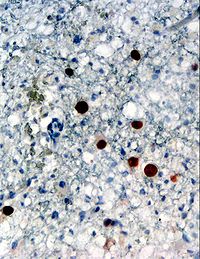JC virus
| JC virus | ||||||||||||||||||
|---|---|---|---|---|---|---|---|---|---|---|---|---|---|---|---|---|---|---|

Immunohistochemical detection of JC virus protein (stained brown) in a brain biopsy |
||||||||||||||||||
| Systematics | ||||||||||||||||||
|
||||||||||||||||||
| Taxonomic characteristics | ||||||||||||||||||
|
||||||||||||||||||
| Scientific name | ||||||||||||||||||
| Human polyomavirus 2 | ||||||||||||||||||
| Short name | ||||||||||||||||||
| HPyV-2 | ||||||||||||||||||
| Left | ||||||||||||||||||
|
The JC virus ( human polyomavirus 2 , JC polyomavirus , John Cunningham virus ; abbreviation: HPyV-2, formerly JCPyV, JCV) belongs together with the SV-40 virus ( SV40 virus ) and the BK virus ( human polyomavirus 1 ) to the family of the Polyomaviridae and therein to the genus Betapolyomavirus . It is considered an opportunistic pathogen of a brain disease with demyelinating foci, the so-called progressive multifocal leukoencephalopathy (PML).
Naming
The name "JC virus" is made up of the initials of John Cunningham, the patient in whom the virus was isolated in 1971 for the first time.
Transmission path
For a long time it was assumed that the virus was transmitted via the respiratory tract , since viral DNA could be detected in lymphocytes of the tonsils. There is now also evidence of a fecal-oral route of transmission with virus detection in the stool.
infection
The infection usually occurs in childhood; about 85% of adults worldwide show antibodies against the JC virus, which are indicative of a previous illness. As a rule, there are no clinical symptoms, but the viral genome remains latent in epithelial cells of the kidney, questionable also in the bone marrow. If the immune system is weak, the virus can be reactivated and spread hematogenously and migrate into oligodendrocytes of the CNS, where PML can then develop.
Detection of the various subtypes of the virus has also been used as a genetic marker for migration and evolution of the human population.
construction
The icosahedral capsid has a diameter of about 45 nm and is made up of 72 capsomers, so-called VP-1 pentamers. The other envelope proteins VP-2 and VP-3 are only present in small numbers.
The circular double-stranded genome of the JC virus consists of 5130 base pairs (bp) and is divided into three sections. On the one hand, a non-coding region with the origin of replication , a region for the large and small T antigen, and a region for the envelope proteins VP-1, VP-2 and VP-3 and the associated agnoprotein. Different arrangements of the non-coding region result in different JC virus variants. The CY strain with a 98 bp long sequence consisting of two 23 and 66 bp inserts is most frequently found in healthy individuals, while the Mad-1 strain consists of two 98 bp tandem repeats and TATA boxes in PML patients . The Mad-4 strain in particular has oncogenic potential because the second TATA box is missing here.
In the animal model, infection with the JC virus, strain Mad-4, resulted in numerous brain tumors, in particular astrocytomas , medulloblastomas and PNET . JC virus DNA is also occasionally detected in surgical specimens from human CNS tumors. In particular, the 80 kDa protein of the large T antigen can bind and inactivate certain key proteins for the development of tumors ( p53 and pRb ).
Web links
- B. Vagner Ramirez, V. Castano Palacio: JC virus: A brief review. In: World J. Neurosci. 3, 2013, 126–130, doi: 10.4236 / wjns.2013.32015
- Virus brain tumor? , Spectrum
Individual evidence
- ↑ a b c d e ICTV: ICTV Taxonomy history: Human polyomavirus 1 , EC 51, Berlin, Germany, July 2019; Email ratification March 2020 (MSL # 35)
- ↑ José Carlos Mann Prado, Telma Alves Monezi, Aline Teixeira Amorim, Vanesca Lino, Andressa Paladino, Enrique Boccardo: Human polyomaviruses and cancer: an overview . In: Clinics (Sao Paulo), 73 (Suppl 1), p. E558s, doi: 10.6061 / clinics / 2018 / e558s , PMC 6157077 (free full text), PMID 30328951 (online September 26, 2018), Fig. 1
- ↑ Ugo Moens, Sébastien Calvignac-Spencer, Chris Lauber, Torbjörn Ramqvist, Mariet CW Feltkamp, Matthew D. Daugherty, Ernst J. Verschoor, Bernhard Ehlers: ICTV Virus Taxonomy Profile: Polyomaviridae . In: J Gen Virol. , 98 (6), pp. 1159–1160, doi: 10.1099 / jgv.0.000839 , PMC 5656788 (free full text), PMID 28640744 , June 22, 2017
- ↑ dsDNA Viruses> Polyomaviridae . In: ICTV Report , June 2017, revised in July 2018, Table 2A
- ↑ BL Padgett, DL Walker, GM Zu Rhein a. a .: Cultivation of papova-like virus from human brain with progressive multifocal leucoencephalopathy. In: Lancet , 1, 1971, pp. 1257-1260. PMID 4104715
- ↑ LA Shackelton, A. Rambaut, OG Pybus, EC Holmes: JC virus evolution and its association with human populations. In: J Virol. 20, 2006, pp. 9928-9933. PMID 17005670
- ↑ H. Petry, C. Goldmann, O. Ast, W. Lüke: The use of virus-like particles for gene transfer. In: Curr Opin Mol Ther. 5, 2003, pp. 524-528. PMID 14601522